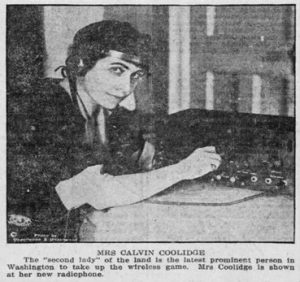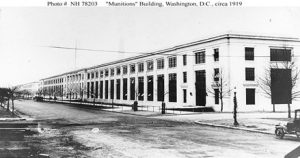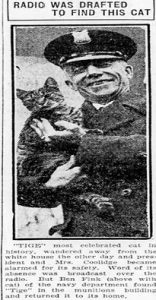By Jerry Wallace
The Coolidges were both pet lovers. The President was particularly fond of cats, while the First Lady was partial to dogs. A pair of kittens arrived at the White House around October 20, 1923, not long after the Coolidges had taken up residency there. Tige, as the male was called, was accompanied by another young feline, named Blacky. Tige established a close bond with the President.[1] Coolidge family biographer Ishbel Ross recounts that the President established a routine with Tige (or the other way around). At the end of each workday, the President pressed a bell to let the staff know that he was returning to the family quarters. At the sound of that bell, Tige dashed to the colonnade, running all the way from the executive offices to the White House proper to greet his master. The President then picked up Tige and draped him around his shoulders, and in that manner, carted the cat off to the second floor.
Friday night, March 21st, 1924 brought a snowstorm to the nation’s capital.[2] The grounds of the White House turned white. It was one of those nights when it was best to curl up by the hearth, but one occupant of the White House, Tige, was not looking to stay by the fire. Now a feisty seven months old, the tomcat decided the time had come for him to venture out on the town. Tige departed the Executive Mansion undetected. Tige’s surreptitious adventure brought him national fame and demonstrated another use for the new medium of radio.

On Saturday morning, March 22nd, 1924, President Coolidge was informed that Tige was missing. Saturday and Sunday passed without White House search parties turning up any sign of Tige. The cat-and-president routine was interrupted. Anxiety over Tige’s fate increased. What had happened to the President’s beloved feline, who was usually so well behaved and fond of his home? Was he lost or stolen, the Coolidges wondered?
By Monday, March 24th, the Coolidges decided that a public appeal for his return was in order. Rather than make the appeal through local newspapers, the First Couple instead decided to turn to the radio. The immediacy of the new medium suited the urgency of the situation. Grace Coolidge was an early radio enthusiast, having her own radio at the New Willard Hotel while her husband was serving as vice president. The First Lady was fond of musical programs and following baseball.

Grace’s Secret Service agent, James Haley, was asked to read an appeal for the cat’s return over the local radio station, WCAP, which had only gone on the air the previous July. That evening, at 8:10 PM, Secretary of Agriculture Henry C. Wallace was preparing to go on the air to discuss agriculture policy, but this time, cabinet business had to wait. Secretary Wallace was told to “stand by.” Instead, the radio audience heard the voice of Haley coming over the air waves:
“We regret to announce that the President of the United States has lost his cat. It was a seven months old Thomas cat, marked like a tiger and answered to the name of Tige. Tige has a very affectionate disposition and Mr. Coolidge was very fond of him. He has not been seen since Friday evening during the snowstorm. The President would appreciate it very much if anyone who has seen Tige would return him to his master. Thank you.”[3]
WCAP had a sister station, WEAF, located in New York City. The stations were connected using long-distance circuits and frequently broadcast the same program simultaneously in both cities. That was the case on the night of March 24th. This meant that the White House appeal was heard throughout most of the country east of the Mississippi. Immediately, the White House was inundated with messages from individuals offering to replace the missing pet. Moreover, the broadcast caught the attention of the print media, and newsmen were soon preparing to inform the country in their morning editions about the missing presidential cat.
The White House appeal worked. This account of Tige’s rescue appeared in Washington’s Evening Star. Early in the morning on Tuesday, March 25th, Tige was espied by U.S. Army Captain E. F. Koenig walking aimlessly in the vicinity of 18th and B Streets, about six blocks from the White House and in the area near the Lincoln Memorial. Captain Koenig encountered no trouble capturing the bewildered Tige. While he did not know that Tige was a White House resident, he could discern that the cat in hand was no ordinary alley cat but one coming from a good home. Captain Koenig then turned Tige over to Captain Edward Sullivan, who was in charge of the Navy guard force at the Munitions Building. Captain Sullivan also had no idea of Tige’s origin, but he did feed the hungry cat and put him into a closet for safe keeping.

Tige’s return brought about a celebration. When told the good news, a warm smile of relief and happiness crossed the President’s face. Mrs. Coolidge, too, was happy. She must have been equally pleased that their radio appeal had worked so well and so quickly.
Newsmen were also happy; they had a good human-interest story featuring President Coolidge’s favorite pet. Most articles were short and good natured. Moreover, they tended to humanize the somewhat stern-looking new President, who was seeking the Republican nomination for the 1924 presidential election. Some Democratic papers, however, attempted to describe Coolidge as overreacting to the loss of a mere cat or to link the story to the hot issues of the day—the Teapot Dome Scandal and the imminent dismissal of an implicated cabinet member, Harry Daugherty. Before Tige was found, the editor of the Brooklyn Daily Eagle wrote a long piece entitled “The Cat and The Statesman” in which he humorously speculated that “Harry M. Daugherty spirited him [the cat] away in a stone-laden bag to the quiet banks of the Potomac.”[4]
Benjamin Fink, the guard whose only involvement was dropping off Tige at the White House, was touched by the Goddess of Fame. He had his picture taken holding Tige with the caption that he had rescued the First Cat.[5] This photo featured in papers across the country. Sadly, the roles played by Captains Koenig, Sullivan, and Bryant in this saga received less attention than they deserved.
As for the White House broadcast, it demonstrated the radio’s power to touch the public. It comes as no surprise then that the Associated Press began its story on Tige thusly: “The radio, often used to locate missing persons and stolen automobiles, was proved to be equally effective in finding missing cats.” This demonstration of radio’s power came with good timing. It caught the interest of radio enthusiasts gathered in Washington for the city’s first Radio Show, whose participants included several high-ranking government officials—including Secretary of Commerce Herbert Hoover. After Tige’s safe return, the Coolidges put a green collar on the tom with “The White House” engraved on the nameplate. Tige continued to roam, but sadly, one day did not return.
[1] William C. Lyon, “At the White House Table When There’s No Company,” Fort Worth Star-Telegram, May 4, 1924, Pg. 4.
[2] “In Winter Attire,” Evening Star, March 21, 1924, Pg. 1.
[3] “The Coolidge Cat,” The Miami News, March 31, 1924, Pg. 6.
[4] “The Cat and the Statesman,” Brooklyn Daily Eagle, March 25, 1924, Pg. 6.
[5] “Kitty, Kitty!,” The Selma Times-Journal, March 29, 1924, Pg. 1.
